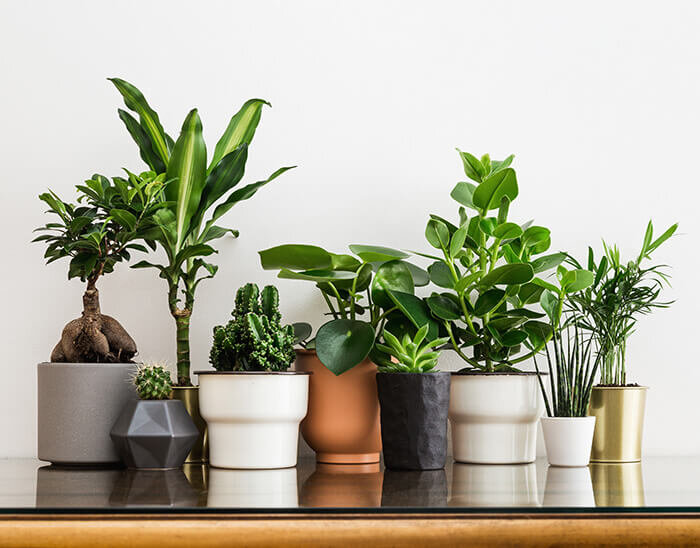Improve The Indoor Air Quality In Your Home With Purifying Houseplants
Whether you spend all day inside or only come indoors to sleep, having clean air in your home is essential. Unfortunately, the air we breathe inside is often many times dirtier than the air we breathe outside.
You might be wondering how that can possibly be the case.
Believe it or not, there are all kinds of indoor air pollutants in our homes that can make us extremely sick. From the VOCs that are emitted from our furniture to household cleaning products, solvents, and other chemical agents, there are lots of nasty particles floating around in the air.
It’s not only the “chemical stuff” you have to worry about, either. In fact, even things like pollen and dust bunnies can make you feel a little foggy-headed.
Not sure how to deal with it? Luckily, there’s an easy solution.
Look anywhere on Instagram, and you’ll likely see just how popular this solution is - you need to add a few house plants.
House plants are known for their ability to improve indoor air quality in your home. People have been using purifying plants to clean the air ever since NASA released its infamous air quality studies in the late 1980s.
When it comes to indoor air pollution, there’s no better way to fight back than with a few purifying plants.
Why Does Indoor Air Quality Matter?
As you’ve likely realized if you’ve spent any amount of time indoors this year during quarantine, it’s easy to find yourself feeling cooped up. Whether you’re sleeping, watching television, or working in your kitchen, experts estimate that we spend up to 90% of our time indoors - a figure that has likely increased as the result of mandatory stay-at-home orders in the wake of COVID-19.
Indoor Air Quality Improves with Houseplants
The more time you spend indoors, the more likely it is that you will be introduced to indoor air pollution.
Indoor air pollution can be blamed on a number of culprits, with the biggest ones being upholstery, carpeting, furnishings, dry-cleaned clothing, paint, building materials, pesticides, cleaning products, mold, bacteria, and of course, any outdoor pollution that enters and is then trapped inside.
One of the most dangerous indoor air pollutants is furniture and paint. Your coffee table could be making you sick! From the paint on your walls to the upholstery on your furniture, just about everything can release volatile organic compounds, or VOCs, such as formaldehyde.
When you are indoors, your exposure to VOCs is much higher. Here, the levels of VOCs are up to five times higher than they are outdoors.
Although everybody is exposed to some form of indoor air pollution from time to time, probably without any issues, there are cases in which serious symptoms can arise. Usually, this is caused by poor ventilation, but if you just happen to be more sensitive, you may find yourself suffering from unexplained symptoms like nausea, headaches, and fatigue.
Health Benefits of Air-Purifying Indoor Plants
In the late 1980s, NASA released a series of studies that indicated how houseplants could dramatically improve the air quality indoors from your new organic mattress to your new living room set. Although the study suggested that it would take many hundreds of plants to truly impact the levels of VOCs in your home, there’s no doubt that even a few indoor plants can dramatically improve the quality of air in your home.
Air-Purifying Indoor House Plants
Indoor plants help reduce levels of carbon dioxide and increase the relative humidity in a home. They remove stale air and act as natural humidifiers, easing or even preventing irritation to your throat, eyes, nose, and lungs.
Not only that, but indoor plants can prevent congestion and coughing and lower your overall stress levels. Some studies even suggest that indoor plants can improve your ability to pay attention!
The more often you interact with your plants, the better, too. That doesn’t mean you need to have a cup of coffee and chat up your spider plant. It just means that simple activities, like repotting or watering your plant, will make you feel the difference.
You can grow just about any kind of house plant to reap the benefits of air purification, but there are some that are a bit more effective than others. These are some of the easiest air purifying plants that you can grow indoors - and they’ll give you a good return on your investment of time and money, too, when it comes to cleaning up the air.
Barberton Daisy
Barberton Daisy Houseplant
If you want to grow a plant that will add color as well as a myriad of health benefits to your home, you should consider growing the Barberton daisy. This lovely plant not only pushes out beautiful blooms in shades of yellow, red, orange, and pink, but it also is great at cleaning the air. It can get rid of all kinds of pollutants, including trichloroethylene, benzene, and formaldehyde, all of which are found in household furnishings, paints, and synthetic fibers.
It doesn’t take much to grow one of these lovely flowers, either. All you need is a room that has lots of natural light. Keep the soil moist, but make sure it’s also well-draining so that your plants’ roots do not become waterlogged.
English Ivy
One easy to grow perennial vine is incredibly effective at reducing air pollutants - and that’s the English ivy.
Certain studies have found that this plant is particularly adept at removing airborne fecal particles (gross!) so it’s a good choice for an indoor plant that you plan on positioning in the bathroom or in a room attached to a bathroom. It’s also great at removing airborne mold particles.
To grow this plant, simply provide it with plenty of water and about four hours of sunlight each day.
Snake Plant
Snake Plant
The snake plant has a funny nickname - mother-in-law’s tongue. Sansevieria trifasciata, as it’s more formally known, is an easy to grow indoor plant that can remove xylene, benzene, formaldehyde, and trichloroethylene from the air. This yellow-tipped succulent plant releases oxygen at night as it works hard to remove pollutants from the air that you breathe.
Xylene is particularly toxic, a chemical that is often used in the rubber and printing industries. Benzene, on the other hand, is commonly used in detergents, varnishes, and floor finishes.
One of the most difficult houseplants to kill, it does have to be watered on occasion. However, it prefers drier conditions. In fact, it is susceptible to overwatering, as the roots can rot in too-wet soil. It can tolerate just about any level of light, too, making it a good choice for any room.
Areca Palm
The areca palm is a unique house plant that is actually biologically engineered so that it can take in carbon dioxide and release oxygen. However, it’s also adept at removing formaldehyde, toluene, and xylene from the air.
An easy to grow plant, it grows well in filtered sunlight and likes to be watered often. The plants grow to about shoulder-height in no time.
Spider Plant
Spider plants are some of the easiest houseplants to grow. This plant, Chlorophytum Comosum ‘Vittatum’, loves to be grown in bright, yet indirect sunlight. The plants grow rapidly and are perfect for beginners or people without self-professed green thumbs. They send out large shoots of foliage with flowers that can eventually grow into baby spider plants.
Spider House Plant
What does that mean?
More bang for your buck, because you can report the babies later to produce brand-new plants! To do this, you’ll just place the babies in their own pot while they are still attached to the mother plant. You can clip them off once they have fully rooted in the soil.
Not only is the spider plant remarkably easy to grow, but it also is known for its ability to remove xylene and formaldehyde from the air.
Aloe Vera
Aloe Vera Houseplant
Aloe vera is not only easy to care for, but it offers a whole host of medicinal benefits as well. If you’ve ever suffered from a nasty sunburn, you are probably already aware of most of them. Aloe has leaves that contain clear liquid packed with amino acids, vitamins, and enzymes that have some serious healing benefits. Not only are these compounds antibacterial, but they’re anti-inflammatory, too.
Aloe can also help remove formaldehyde from the air, so there's plenty of reasons to consider growing it on your windowsill.
Broad Lady Palm
The broad lady palm is another plant that can help reduce the level of air pollutants inside your home. Unlike many others, however, it can help reduce levels of another dangerous chemical - ammonia. Ammonia is found in many cleaning products, so you might not think it’s that bad for you - but it is. Broad lady palm is one of the few plants that can help remove it.
It can be expensive to buy a fully-grown broad lady plant, so you may want to shop around for a small one or grow it from seed first instead. This plant loves to be grown in humidity and prefers ample watering. It can be grown in a bathroom if you want a more low-maintenance plant. Here, it will naturally take up humidity from the room so you can reduce your watering chores.
Red-Edged Dracaena
There are more than 40 different types of dracaena plants, all of which are easy to grow in an office or home. Red-edged dracaena is one of the best choices you can make. Also known as the dragon tree, this plant likes to be grown in bright sunlight. It has leaves with bright red trimming, which can add serious style to your home.
Red-Edged Dracaena Plant
This plant can be toxic to cats and dogs when it is consumed, so be aware of the potential risks if you’re growing it around your four-legged friend. They require large pots, too, since they can grow up to three feet tall.
Dracaena plants do well with irregular watering and actually prefer to be misted instead of watered directly. The plant has impressive air cleaning abilities and can remove xylene, trichloroethylene, benzene, and even formaldehyde from the air.
Weeping Fig
The ficus, also known as the weeping fig or Ficus benjamina, can grow up to ten feet tall. This plant loves being grown in bright, indirect sunlight and can remove all kinds of pollutants from the air, including trichloroethylene, formaldehyde, and benzene.
It is incredibly low-maintenance. Native to southeast Asia and Australia, it grows best in soil that dries out fully between waterings. You can take it outside when the temperatures outdoors area above freezing, too. This plant has been popular since Victorian times, so you can imagine how easy it is to grow.
One consideration to make? Weeping figs don’t like being grown in drafty areas. It is sensitive to changes in temperature, so make sure you keep it away from heat registers and drafty windows.
Chinese Evergreen
Chinese Evergreen House Plant
The Chinese evergreen is one of the most common, low-maintenance indoor plants you can grow. It releases an unusually high level of oxygen and works hard to remove chemicals from the air, including formaldehyde and benzene. It’s often grown in China for this reason alone.
Unlike many other houseplants, this one grows best in full shade - you don’t need to position it near a sunny window. While a bit of darkness is best, keep in mind that, if you only have a sunny location to put it in, that’s okay, too. Just make sure you mist the leaves every now and then to prevent them from turning brown.
It needs to be watered only occasionally. As long as the soil is kept moist on a regular basis, there’s not much else you need to do to keep it healthy and happy.
House Plants Are Known To Dramatically Improve Air Quality
These house plants or houseplants are known for their ability to dramatically improve the quality of the air you breathe from your bedroom to your kitchen. While it would take nearly 700 plants in a standard-sized home to really go to battle against the most malicious air pollutants, even just one plant can make a major difference in providing you with clean air.
Consider growing a few of these house plants in your home to clean up the air - you’ll breathe easy knowing they’re removing many of the worst contaminants from your home.
Rebekah Pierce is a professional social blogger and has worked on several online publications including Citrus Sleep. Rebekah is an experienced content writer and copyeditor. You will find many of her works throughout CitrusSleep.com that cover a wide array of subjects including sleep education, natural, sleep products, electronics, fashion and many more. She is passionate about her work and family.
Follow Lisa at Rebekah Pierce




















